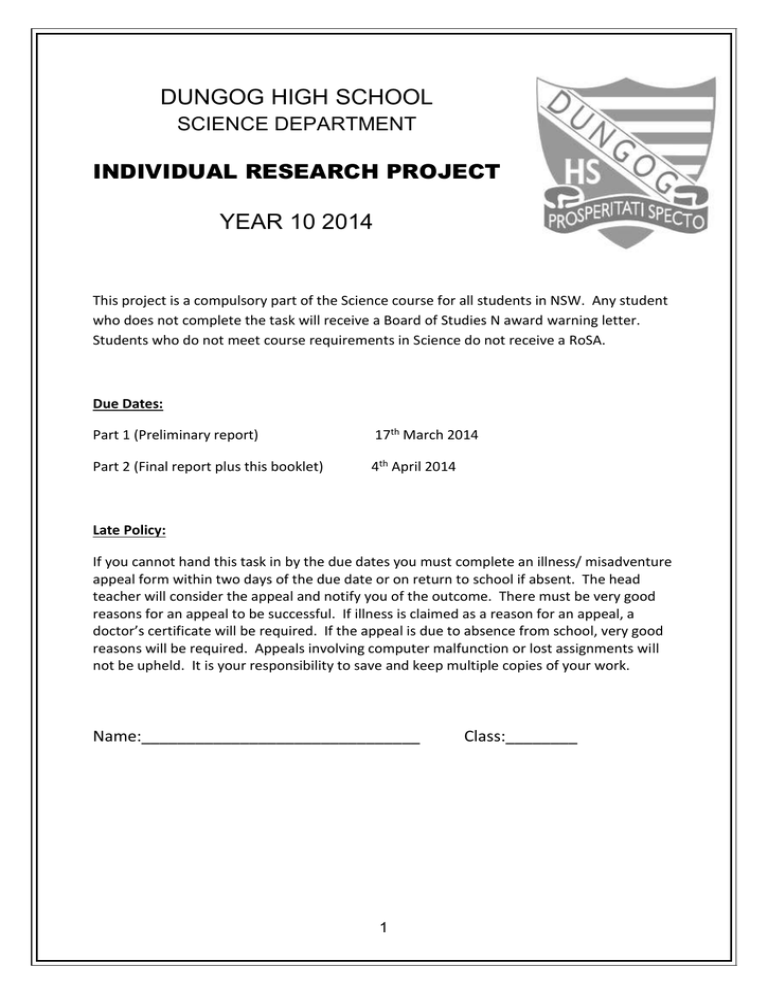
DUNGOG HIGH SCHOOL
SCIENCE DEPARTMENT
INDIVIDUAL RESEARCH PROJECT
YEAR 10 2014
This project is a compulsory part of the Science course for all students in NSW. Any student
who does not complete the task will receive a Board of Studies N award warning letter.
Students who do not meet course requirements in Science do not receive a RoSA.
Due Dates:
Part 1 (Preliminary report)
17th March 2014
Part 2 (Final report plus this booklet)
4th April 2014
Late Policy:
If you cannot hand this task in by the due dates you must complete an illness/ misadventure
appeal form within two days of the due date or on return to school if absent. The head
teacher will consider the appeal and notify you of the outcome. There must be very good
reasons for an appeal to be successful. If illness is claimed as a reason for an appeal, a
doctor’s certificate will be required. If the appeal is due to absence from school, very good
reasons will be required. Appeals involving computer malfunction or lost assignments will
not be upheld. It is your responsibility to save and keep multiple copies of your work.
Name:_______________________________
1
Class:________
Choosing a Topic
Select a topic that interests you, something that you are prepared to work on for several
weeks, at least. Is there a problem that you would like to solve?
Start by doing some reading. There are many books and websites available which contain
ideas for projects.
It is best for you to be CREATIVE and ORIGINAL. Make the project your own unique
endeavour.
Project Ideas
About Plants
Most plant investigations would involve
too long a time frame for this project.
Into everyday problems
e.g. What is the best way to remove ink
marks from school clothes?
Involving Chemistry
e.g How can new dyes or indicators be
made from natural products?
Studying animals
e.g. How can I prevent snails from eating
lettuce seedlings in my vegetable garden?
Of consumer interest
e.g. How can you best prevent bread or
cheese or yoghurt from going mouldy?
Studying electricity
e.g How can a lemon or an orange act as a
battery to power a clock?
For more Ideas
See Appendix 1 and the following website has some more ideas
http://www.csiro.au/resources/ps1z1.html
2
Planning What to Do
What are you actually going to do?
What are you going to find out?
What measurements and observations will you need to take?
What results do you expect to obtain?
Which factors will affect the results?
Planning your Experiment
The hypothesis
Form a hypothesis. This is an “educated guess” about what you think will happen in a
certain set of circumstances or conditions. You will need to decide what these conditions
are. It is important that you keep as many factors the same as possible, so that you can
clearly interpret the results. Your hypothesis must be able to be tested. It needs to be
simple and very specific.
Equipment
You will need to decide on the equipment that you are going to use and the method that
you will use.
The Variables
When you carry out an experiment there will be several conditions or factors that could
change during the experiment. These factors or conditions are called VARIABLES.
Some variables will be kept the same throughout the experiment while others are changed.
For your experiment to be a FAIR TEST, as many variables as possible should be kept the
same while you change one particular variable. In this way you can sort out which change
led to the results that you obtained. If only one variable changes, while all others are kept
the same, the results that you can detect must be caused by the variable which has
changed.
Accuracy
When making measurements, you need to be careful to ensure that they are as ACCURATE
as possible.
To do this, you will need to think carefully about what you are trying to measure, and the
tools that are available to use for measuring
Repeating an experiment more than once will give you more confidence in your results. It
also enables you to detect results that are unusual. You need to keep repeating your
experiment until you get several answers which are very similar.
3
Preliminary Report
You must complete this sheet and have your project approved by your teacher before
starting any experiment. You will not be given approval if your teacher considers it
dangerous, impractical, harmful to living things or the environment etc. You also need to
have your parent’s approval for your particular project as projects may sometimes involve
expenses or inconvenience at home.
Keeping a Record
An important part of carrying out your investigation involves keeping track of the work that
you do and the decisions that you make. You could use One Note on your computer or
obtain a book in which you can record your original idea and the comments that other
people made when you discussed it with them.
Your teacher will probably want to check it from time to time. You will need touse it to keep
track of the time you spend on your project.
In your log book, record your hypothesis, your research and discussions, the aim, the list of
equipment that you need, your method, all results and all other work. If you make changes
to the method or if you have problems which need to be overcome, this information should
be recorded. Can also include diagrams and/or photos where necessary.
Record all your thoughts and ideas in your book. Make notes and comments in your book. It
is like a diary.
Your Log Book is not your final report.
4
Recording your Results
Start thinking about how you are going to report you results. Could you take some
photographs to show what happened? Would a graph or a diagram be useful? Can the
information be recorded in a table to make comparison easy? Look at the results and think
about what they mean? Has your original aim been answered or do you need to carry out
further experiments to help you come to a conclusion. Are any of your results unexpected?
How can you explain them?
You do need to be able to prove that you conducted the experiment. Photographs, even
taken on your phone are a great thing to include.
Discussion and Conclusion
The last part of your project involves a discussion of the results that you obtained. Describe
any difficulties that you had carrying out the experiment and interpreting the results. Any
suggestions for how the experiment could be improved should be included here too. You
also need to outline your research and discuss how it relates to your experiment and your
results.
Finally, write a conclusion based on the results that you obtained.
Aknowledgements
It is important in any project that all the help that you received is acknowledged with a
bibliograpy. A bibliography is a list of books, magazines, internet sites and other resources
you have used to complete a task. A bibliography always comes at the end of a piece of
work and is always arranged in alphabetical order. A bibliography must include:
the name of the author or editor
the publisher of the book
the date the item was published
the internet address
the title of the article
“n.d.” stands for ‘no date’
the full title of the book
For example:
Book
Whalley, K. 2003, Science Focus 1, Pearson Longman, Sydney.
Webpage
Heaps, S. 1996 (updated 2009), ‘History of chemistry ’, Chemistry, Wikipedia. Retrieved 1
January 2014 from http://www.wikipedia.org/chemistry.html
Webpage (No Author, no publication date)
“Light: The eye and colour vision” n.d., Physclips, UNSW. Retrieved 3 March 2014 from
http://www.animations.physics.unsw.edu.au/light/eye-colour-vision/
5
The Final Report
The following is a list of headings that you should use when writing your report.
Title
Hypothesis
Aim
Variables
o Dependent Variable
o Independent Variable
o Controlled Variables
Equipment
Safety Issues
Background Information
Method
Results
Graph
Analysis
Conclusion
Bibliography
6
PRELIMINARY REPORT SHEET
Name: __________________________
Science Class: _____________
Teacher: ___________________________
Title of Project:______________________________________________________
My Hypothesis:
___________________________________________________________________
Brief description of project:
___________________________________________________________________
___________________________________________________________________
___________________________________________________________________
Controlled variables
Independent variable
Dependent variable
(What I will keep the same)
(What I will change)
(What I will measure)
Parent Acknowledgement:
I am aware that the science project that my son/daughter is about to commence is a major
assessment task and will be used in the calculation of the end of year grade in science. I am
aware of the area of investigation and approve of this topic. I am also aware that the project
is designed as an individual student assessment, and the final date for submission of the
completed project is 4th April 2014.
Signature (parent/guardian) ______________________________
Teacher approval _________________________
7
Date _____________
Risk Assessment Form
Likelihood of something happening
Severity
Very likely
could happen
at any time
Likely Could
happen
sometime
Unlikely could
happen but
rarely
Very unlikely
could happen
but probably
never will
Kill or cause permanent
disability or ill health
1
1
2
3
Long term illness or
serious injury
1
2
3
4
Medical attention and
several days off work
2
3
4
5
First aid needed
3
4
5
6
The table above gives a number, which indicates the degree of risk involved in the use of a
piece of equipment or a chemical.
1
indicates the greatest risk and should be avoided
6
indicates a minimal risk
Your risk assessment
List the equipment, chemicals and biological material, used in your experiment, that may be
hazardous and why it may be hazardous. Give each item a number based on the table above
and list the precautions taken.
Outline of Risk
Risk Number
8
Precautions to mitigate risk
Marking Criteria
Name:____________________________
Mark
available
1
1
1
1
1
1
3
2
1
1
2
2
1
1
1
1
2
4
3
2
1
1
1
1
1
3
1
3
Class:_______
The complete work should show
Title :
The title of the experiment is appropriate
Hypothesis:
An appropriate hypothesis for the experiment is stated
Aim:
Correct format (not a question etc)
Is succinctly stated
The independent variable is identified and described
The dependent variable is identified and described
All controlled variables are identified and described
The equipment used in the experiment is listed
Risk assessment:
Safety issues identified
Safety precautions have been taken
Risk assessment completed
Background Information
Method:
Instructions written in numbered steps
Each instruction must be a command
There are no personal pronouns (I, we, us etc) and it is written in
the present tense
It uses scientific language
Method is complete and will allow a solution to the problem
Experimental design:
Experiment could produce valid results; repetition if appropriate;
innovative and interesting.
Results:
Table with appropriate headings and units
Photos, samples or other physical evidence
Graph of results:
Title
Labelled axes
Correct units used
Points correctly plotted
Appropriate scale
Analysis
What scientific principles have been demonstrated by the
experiment?
Discuss your results and explain any trends.
Show evidence of changes made to experiment or suggestions to
improve experiment.
Discuss your research and relate it to your experiment
9
Mark
awarded
1
1
1
2
1
1
1
1
3
60
Conclusion:
Clearly state the results of the experiment..
Compare the results with your hypothesis.
Log book:
Shows dates
Evidence of planning
Evidence of research and/or consultation
Presentation:
Legible or word processed
Correct grammar and spelling
Correct use of scientific language
Bibliography and acknowledgement of help received; several
sources and correct format.
TOTAL MARK
10
Project Ideas
Do not start any investigation until the project has been approved by your teacher
Design learning experiments to examine
Investigate the relationship between
factors affecting learning, eg noise
slope angle and soil depth or erosion
rates
Investigate strength in a substance, eg
Investigate the distribution of mosses
glue, cotton, hair, paper, elastic band,
building materials etc
and light level
Make bricks out of various materials and
Are stains removed faster in hot or cold
test their strength
water
Test the colourfastness of various
Which fabric is easiest to clean (wash,
materials
remove stains from)
Investigate the effectiveness of various
Which material is most resistant to
soaps or detergents
creasing
Test various hairsprays for effectiveness
On what type of surface do ice cubes
melt fastest – plastic, wood, metal or
ceramic
Test nail polishes for hardness
Compare the effectiveness of various
Do all cereals absorb the same amount
shampoos
of milk
Investigate whether warm or cold water
Do all plastic bags, shopping bags carry
freezes first
the same weight without breaking
Investigate whether the use of
How strong are plastic wraps
aluminium foil makes a difference in
cooking times
How strong is a toothpick
Investigate whether there is a
What type of paper aeroplane will travel
relationship between gender and
reaction time
the furthest
Does the height of a person affect their
Investigate the relationship between
ability to run 100m in a given time
concentration and the effectiveness of
disinfectors
What conditions affect the solubility of
salt or sugar
Investigate the effectiveness of rust
Does the type of wood affect the wood’s
inhibitors
ability to soak up water
Investigate the effectiveness of oven
What brand of paper towel is the most
cleaners
absorbent
Investigate the effectiveness of batteries
Which detergent will dissolve oil best
Investigate the warmth of various socks
Test various board waxes for
effectiveness
The effect of a dye on different materials
11








